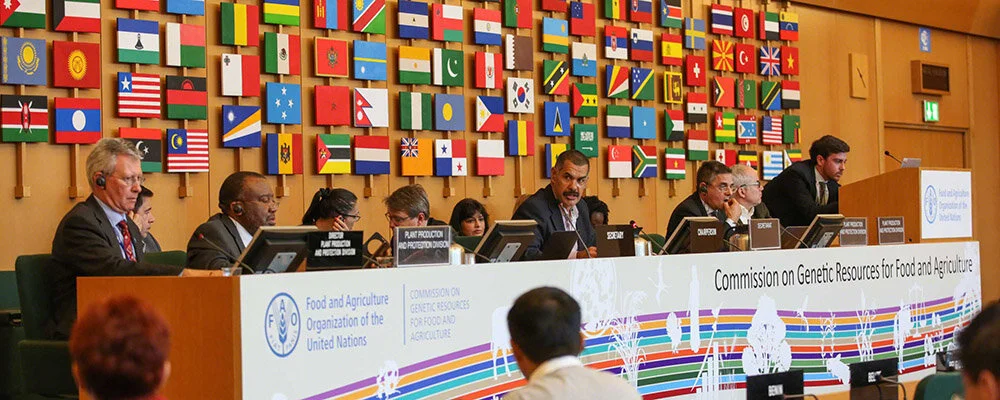Report on The Commission on Genetic Resources for Food and Agriculture
(Photos by IISD/ENB | Kiara Worth)
FAO, Rome, Italy
The 17thRegular Session of the Commission on Genetic Resources for Food and Agriculture took place from February 18-22 at FAO in Rome this week. Many important findings were discussed, and several interesting side events occurred. One of which featured our coordinator, Devra Jarvis on the panel.
The most important part of this event is the release of the first-ever State of the World’s Biodiversity for Food and Agriculture report. Read it here.
The Commission
Delegates completed their deliberations on genetic resources for food and agriculture and discussed issues such as:
Reports: The report on the State of the World’s Biodiversity for Food and Agriculture (SOW-BFA), Aquatic and Plant GRFA reports and plans
Nutrition: The review of work on GRFA and Nutrition. Some geographic regions such as Africa requested that FAO support research on using GRFA to support nutrition
Crop Promotion: Other geographical regions such as Asia called for multi-level promotion of underutilized crops
Home Gardening: Ecuador specifically requested the research and promotion of home gardening which is an extremely important and widespread source of small scale food production which more people should be educated on.
Representatives from international organizations also contributed interesting points and raised awareness about current issues such as:
Climate Change: Tammi Jonas, president of The Australian Food Sovereignty Alliance (AFSA) made an intervention on the increasingly urgent need to take serious action against climate change, giving concrete examples of the horrifying reality of this global issue in Australia. She urged the commission to take more aggressive action to implement solutions globally to reverse these devastating effects.
Indigenous Peoples: The importance of fair representation of the rights of indigenous peoples around the world for agricultural policy
(Photos by IISD/ENB | Kiara Worth)
Coordinator Devra Jarvis made a statement on behalf of PAR regarding its overall contribution to the State of the World’s Biodiversity for Food and Agriculture report and the preparation of the thematic study on “The contributions of biodiversity for food and agriculture to the resilience of production systems”
Side Events
Monday February 18: The Guardians of Seeds: a Photo Exhibition by OXFAM Novib
Oxfam Novib and partners created a beautiful collection of images featuring smallholder women farmers from Peru, Laos and Zimbabwe with their seed stories. From not marrying until you can peel a potato without waste to heartbreaking stories of climate change’s effects on how certain crops can be cultivated, many beautiful tales were told.
Devra Jarvis speaks at a side event.
Tuesday February 19: The Role of Agricultural Biodiversity in the Scaling-up Agroecology Initiative
IPES-Food and GAFF organized an event to host the fascinating discussion on exploring the important link between agricultural biodiversity management on farm and agroecology. Speakers discussed policy and on-farm successes in agroecology, presented progress on a seeds of resilience initiative of the GAFF and showed the role that this initiative could play in the FAO’s Scaling-up Agroecology Initiative, approved by COAG in October 2018.
PAR coordinator Devra Jarvis played a key role on the panel and presented information on:
Various approaches to choosing and implementing varieties
The accessibility, performance and benefits from diversity in the production system
Intraspecific diversity agroecological strategies
Marketing for Biodiversity: “How do you market 5 different varieties of mango?” -Devra Jarvis
A new project: A university semester course: “Placing Crop Biodiversity at the Center of Agricultural Production and Resilience” in 24 countries and 60+ universities
CAIs (Centers of Agricultural Innovation): a one stop center supporting small holder farmers to access, use and profit from increase crop genetic diversity in their production systems.
Wednesday February 20: A Nordic approach to the saying “Eat them to Save Them”: Examples of Adding Value to Traditional Breeds
Photo: NordGen
NordGen organized an unique collection of presentations on native breeds of farm animals in the Nordic region as well as the research they are conducting to better understand the advantages of raising and eating these animals. They argue that a solution to reviving these native breeds such as cows would be to eat them! This way, farmers would raise more of them and be able to gain a return on their investment of raising a more complex breed by selling their meat to an interested consumer. NordGen also discussed with attendees the increasing importance of marketing to consumers, explaining way why it’s better to eat native breeds of cows instead of a foreign breed used in industrial style production. The first step to be able to do this is more research on the benefits to the environment and health of these breeds.





